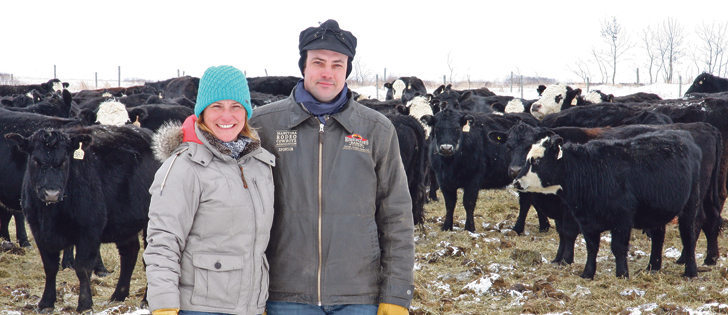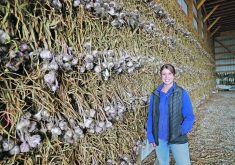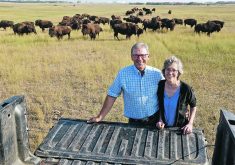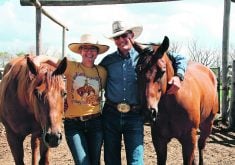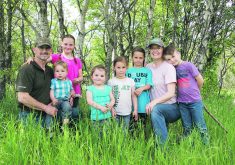Raising cattle, running a tack supply business and serving on producer associations while raising three children keep family busy
WHITEWOOD, Sask. — Raising cattle in southeastern Saskatchewan is far different than in the southwest where Ryan Beierbach grew up.
However, a desire to walk his own path led him and his family to the Whitewood area from the Cypress Hills south of Fort Walsh about 15 years ago.
Here, he and Tania, who grew up on a hay operation in Creston, B.C., have established a 500-head cow-calf ranch and a ranch supply and tack business while raising daughters Lara, 12, and Rana, 11, and son Jace, 10.
The couple met while attending Lakeland College in Vermilion, Alta. Ryan studied agri-business while Tania was taking western horsemanship. She later took a home care course as well.
Read Also

AgriStability updates offer stronger support for farmers
One of the most significant updates to the AgriStability program for the 2025 program year is the increase in the compensation rate.
After a few years on a family ranch in the Medicine Hat area, they traded warm winters and native grass for heavy snow and tame forage.
Converting marginal cropland was an affordable option and they now own 3,300 acres and rent another 1,500. They seed some farmland for feed production and also send 200 cows to a custom grazer.
Feeding silage and extensive grazing in winter give way to an intensive grazing plan that involves moving yearlings every two or three days and cows every three to six days, depending on the time of year.
They have been breeding their Black Angus cows to Hereford bulls for the last six years. Calving will start around May 10.
“I think we get bigger calves with the cross,” said Ryan.
“And they make better cows.”
They have found that first-cross bred heifers are easy to sell, and their focus is raising moderate, easy-doing females that are sound, with good udders and feet.
Tania is a fan of the white-faced and brockle-faced cows.
“Cattle have become more my thing,” she said. “I like my girls.”
High Plains Ranch is also the vantage point from where Ryan watches the cattle industry as chair of the Saskatchewan Cattlemen’s Association.
He is serving a second year in that role after several terms as the director for District 1. Previously he sat on the Saskatchewan Stock Growers Association board.
“Everybody that is in this industry kind of owes it to the industry to put some time back,” Ryan said.
“This way you can control your own destiny by influencing policy.”
Added Tania: “And he likes it, the politics.”
Ryan’s father and grandfather were both involved in the SSGA, and he said that likely led him to do the same.
“Personally, I probably benefit from it too, talking to producers from all over and seeing other operations.”
He said he has learned that governments value input from organizations, and they will get their information from industries that provide it if the cattle industry doesn’t speak up.
The SCA has suffered growing pains since it was established to administer the check-off funding collected on all cattle marketings. The SSGA had that role for years, and there were hard feelings about a government-legislated development commission taking it over.
“It’s better for sure, but there’s still areas where we struggle,” Ryan said.
Earlier boards spent time dealing with personalities and finding their feet. He credits past-chair Mark Elford with working to bring the members together and understand they were all there for different reasons but ultimately for the collective goal of improving the industry.
The SCA now focuses on strategic planning and being the lead voice for cattle producers in the province.
Ryan said the organization wants to encourage American and eastern Canadian feeders to bid more often on Saskatchewan cattle.
“That’s a role SCA can play in making producers more profitable,” he said.
Improvements to risk management programs such as livestock price insurance and forage insurance are also priorities.
“If we’re competing for acres, and the government subsidizes crop insurance premiums, we have to make sure it’s a comparable program,” he said.
Ryan is a graduate of the Cattlemen’s Young Leaders program and has also served as a mentor. It’s too soon to say if their children will stay in the business, but Tania said they are now at an age where they can help move cattle and take on other ranch chores.
They are busy with high school rodeo, hockey and school clubs, which means their parents are busy, too.
High Plains Ranch Supply, the business they began post-BSE to help pay the bills, also takes time.
“It wasn’t a big risk because we started small,” said Ryan.
“We expanded it as it made sense.”
They buy booth space at three significant trade shows each year — Canadian Western Agribition in Regina, Equine Expo in Saskatoon and Manitoba Ag Ex in Brandon — but otherwise operate from a trailer in their farmyard.
“Once it warms up there will be more people stopping in,” Tania said, but generally about one-third of their business is done at trade shows, another third by phone or email and the remainder from the trailer.
It can make for some long days, she said, but it also allows them to be home taking care of the cows and their family.


